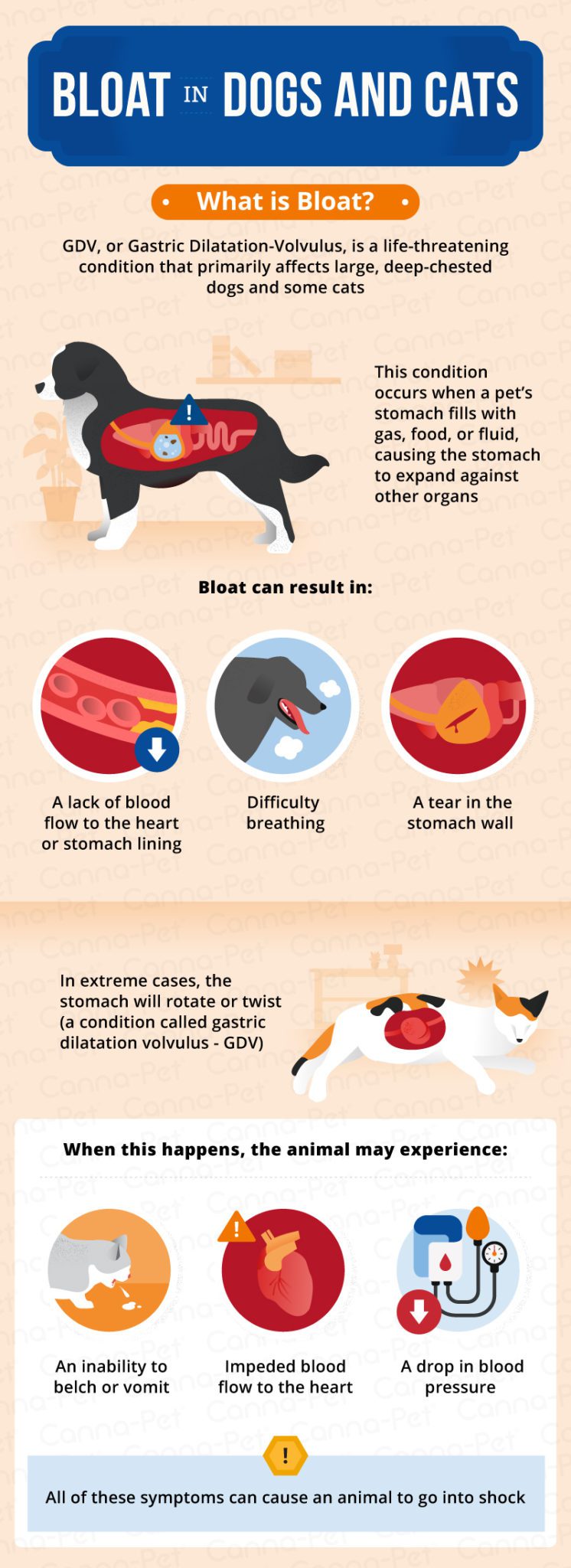Key Takeaways:
- Bloat in dogs, also known as gastric dilatation-volvulus (GDV), is a life-threatening condition that requires immediate veterinary attention.
- Large and deep-chested breeds are more prone to developing bloat, but it can occur in any dog.
- The main symptoms of bloat in dogs include a distended abdomen, restlessness, unproductive vomiting, and difficulty breathing.
- Preventive measures such as feeding multiple small meals throughout the day, avoiding exercise before and after meals, and using slow-feed bowls can help reduce the risk of bloat.
- If you suspect your dog has bloat, it is crucial to seek veterinary care immediately as GDV can rapidly progress and be fatal without prompt treatment.
Are you a dog lover? Do you want to ensure the health and well-being of your furry friend? If so, then understanding the topic of bloat in dogs is essential for you. Bloat, also known as gastric dilatation-volvulus (GDV), is a serious condition that can affect dogs of all breeds and sizes. It occurs when the stomach fills with gas or fluid, causing it to twist on itself. This can lead to a range of symptoms, from discomfort and bloating to life-threatening complications. By delving into this subject, you will not only gain valuable knowledge about how to prevent and recognize bloat in dogs but also be equipped with the tools to potentially save your pet's life. So let's dive right in and explore this important topic together!
Understanding Bloat in Dogs: What You Need to Know
Bloat is a serious condition that can affect dogs, and it's important to understand what it is. Bloat, also known as gastric dilatation-volvulus (GDV), occurs when a dog's stomach fills with gas and becomes twisted. This can be extremely painful and life-threatening for the dog.
When a dog experiences bloat, the twisted stomach can prevent blood flow to vital organs, leading to tissue damage and even organ failure. Without prompt medical intervention, bloat can be fatal. It is crucial for dog owners to recognize the signs of bloat so they can seek immediate veterinary care if necessary.
What Causes Bloat in Dogs?
The exact cause of bloat in dogs is not fully understood, but there are several factors that may contribute to its development. These include:
- Eating too quickly: When a dog eats too fast, they may swallow air along with their food, which can lead to bloating.
- Exercising after eating: Vigorous exercise immediately after a meal can increase the risk of bloat.
- Large meals: Feeding your dog one large meal per day instead of smaller meals throughout the day may increase the likelihood of bloat.
- Breed predisposition: Certain breeds, such as Great Danes, Boxers, and German Shepherds, are more prone to developing bloat than others.
How Does Bloat Happen?
When a dog's stomach fills with gas and becomes twisted, it creates a dangerous situation. The build-up of gas causes the stomach to expand rapidly, putting pressure on nearby organs and blood vessels. This can lead to a decrease in blood flow to vital organs, which can be life-threatening.
The twisted stomach also prevents the dog from being able to vomit or pass gas, further exacerbating the problem. As the condition progresses, the dog may experience severe pain, difficulty breathing, and signs of shock. Immediate veterinary attention is essential to relieve the pressure and correct the twisted stomach.
Causes of Bloat in Dogs: How it Happens and What to Watch For
Bloat, also known as gastric dilatation-volvulus (GDV), is a serious condition that can occur in dogs. It happens when the stomach fills with gas or fluid, causing it to expand and twist. This can be extremely painful and life-threatening for your furry friend. There are several factors that can contribute to the development of bloat in dogs.
One of the main causes is eating too quickly. When a dog gobbles down their food too fast, they swallow air along with it. This air can accumulate in the stomach, leading to bloating. Additionally, certain dietary factors may increase the risk of bloat, such as consuming large meals or eating foods high in fat.
Another factor that can contribute to bloat is genetics. Some dog breeds are more prone to developing this condition than others. Breeds with deep chests, like Great Danes and Boxers, have a higher risk of bloat. Other factors that may increase the likelihood of bloat include age (older dogs are more susceptible), gender (male dogs are at a slightly higher risk), and having a history of previous episodes.
Symptoms of Bloat in Dogs: How to Spot the Warning Signs
Recognizing the symptoms of bloat is crucial for early intervention and potentially saving your dog's life. The signs can vary depending on the severity of the condition, but there are some common warning signs you should watch out for.
One major symptom is a distended abdomen. If your dog's belly appears swollen or bloated, it could be a sign of bloat. Other symptoms include restlessness, pacing, excessive drooling, unproductive attempts to vomit (retching), and difficulty breathing.
In severe cases, your dog may exhibit signs of shock such as pale gums, rapid heartbeat, and weakness. It's important to note that these symptoms can progress rapidly, so immediate action is crucial.
If you suspect your dog may be experiencing bloat, don't hesitate to contact your veterinarian or an emergency animal hospital. Time is of the essence when it comes to treating this condition.
Breeds Prone to Bloat: Which Dogs are at Higher Risk?
While any dog can develop bloat, certain breeds are more susceptible than others. Understanding which dogs are at higher risk can help you take preventive measures and be more vigilant in monitoring their health.
Large and giant breed dogs with deep chests have a higher predisposition to bloat. Some examples include Great Danes, Boxers, German Shepherds, Doberman Pinschers, and Saint Bernards. These breeds often have a narrower stomach base and weaker ligaments supporting the stomach, making them more prone to twisting.
Age also plays a role in the likelihood of developing bloat. Older dogs tend to have a higher risk compared to younger ones. Additionally, male dogs are slightly more susceptible than females.
It's important to note that while certain breeds may be genetically predisposed to bloat, any dog can be affected regardless of breed or size. Therefore, all dog owners should be aware of the symptoms and take necessary precautions.
Suspecting Bloat in Your Dog? Immediate Actions You Can Take
If you suspect your dog is experiencing bloat, it's crucial to act quickly as this condition can become life-threatening within hours. Taking immediate actions can potentially save your pet's life before reaching veterinary care.
Firstly, do not attempt home remedies or wait for the symptoms to resolve on their own. Contact your veterinarian or an emergency animal hospital immediately for guidance.
While transporting your dog to the veterinary facility, try keeping them calm and quiet as stress can worsen the condition. If possible, elevate the front end of your dog's body slightly to help reduce the risk of stomach twisting.
Do not offer food or water to your dog, as they may worsen the bloating. It's important to follow the instructions provided by the veterinary professionals and provide them with accurate information about your dog's symptoms and medical history.
Remember, time is of the essence when it comes to bloat. Acting swiftly can greatly increase the chances of a positive outcome for your beloved pet.
Preventing Bloat in Dogs: Tips to Keep Your Pet Safe
Preventing bloat in dogs is crucial for their overall health and well-being. While it may not be entirely preventable, there are steps you can take to minimize the risk and keep your furry friend safe.
One important measure is to feed your dog smaller meals throughout the day instead of one large meal. This helps prevent them from eating too quickly and swallowing excessive air. Additionally, using slow-feed bowls or puzzle toys can encourage slower eating habits.
Avoid feeding your dog immediately before or after vigorous exercise, as this can increase the likelihood of bloat. Instead, allow for a resting period before and after meals.
It's also recommended to avoid elevated feeding bowls unless specifically advised by a veterinarian. Contrary to popular belief, elevated bowls have not been proven to reduce the risk of bloat and may even contribute to its development in certain cases.
Regular exercise is important for maintaining overall health but avoid intense physical activity right after meals. Gradual exercise before and after meals is generally safer.
Lastly, if you have a breed that is genetically predisposed to bloat, consider discussing preventive measures with your veterinarian. In some cases, a surgical procedure called gastropexy may be recommended to secure the stomach in place and reduce the risk of twisting.
By implementing these preventive measures and staying vigilant about any changes in your dog's behavior or health, you can help reduce the risk of bloat and ensure a happier, healthier life for your furry companion.
In conclusion, bloat in dogs is a serious condition that can be life-threatening. It is important for dog owners to be aware of the signs and symptoms and seek immediate veterinary care if they suspect their dog may have bloat. Taking preventative measures such as feeding smaller meals and avoiding vigorous exercise after eating can help reduce the risk of bloat.
How do you relieve bloat in dogs?
The treatment for bloat in dogs is typically uncomplicated. Dogs are usually admitted to a hospital where they receive intravenous fluids and sometimes medication. Additionally, they are frequently taken for walks to encourage movement of the digestive system, aiding in the swift passage of gas and food through the body.
Can dog bloat resolve on its own?
If you observe symptoms of bloat in your dog, it is crucial to seek immediate veterinary assistance or visit an emergency clinic. Bloat is a severe medical condition that can result in fatality and does not resolve on its own. It is important to act rapidly.
Will a dog with bloat try to poop?
When a dog experiences bloat, it will attempt to vomit and may produce foam or belch. It will also try to have a bowel movement, but only diarrhea will be expelled. The dog is trying to alleviate the pressure in its twisted stomach, but is unable to fully relieve it.
How quickly does bloat set in for dogs?
The condition usually occurs within a few hours of consuming a big meal, although it can happen at any time. It's important to note that dogs weighing over 100 pounds have a 20% chance of experiencing bloat during their lifetime.
How do dogs act when they have bloat?
Symptoms of a swollen and firm abdomen, inability to vomit despite retching, excessive drooling, and abdominal pain upon touch were observed on May 22, 2023.
What can trigger bloat in dogs?
Dog bloat can occur from overeating or drinking excessively, which stretches the stomach. Another common cause is when a dog swallows air, often resulting from eating too quickly or engaging in vigorous exercise right after a meal.

















